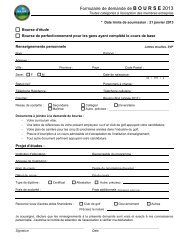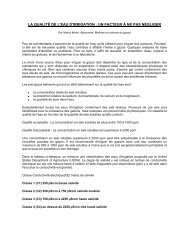Le 1er salon de l - Association des Surintendants de Golf du Québec
Le 1er salon de l - Association des Surintendants de Golf du Québec
Le 1er salon de l - Association des Surintendants de Golf du Québec
- No tags were found...
You also want an ePaper? Increase the reach of your titles
YUMPU automatically turns print PDFs into web optimized ePapers that Google loves.
s’agrandit chaque fois qu’on a 20 mm ou plus <strong>de</strong> base en utilisant un Kubota MX080. Nous avonspluie en-<strong>de</strong>ça <strong>de</strong> 24 heures. <strong>Le</strong>s côtés <strong>de</strong> ce ruisseaudoivent être renforcés. <strong>Le</strong> projet a démarré gravelle et <strong>du</strong> graviat <strong>de</strong> grosseur moyenne afin <strong>de</strong>délimité les côtés, aplati le fond en utilisant <strong>de</strong> lale 16 décembre 2009 par une livraison <strong>de</strong> 120 tonnes<strong>de</strong> roches rouges que nous avons sorties et placer les roches, on a éten<strong>du</strong> un film géo-textilesécuriser la base d’abord. Avant <strong>de</strong> commencer àséparées par grosseur – petites, moyennes et très sur le fond et <strong>de</strong>rrière les roches. La portion lagran<strong>de</strong>s : 50 livres , 1500 livres et jusqu’à 2000- plus difficile est <strong>de</strong> choisir les bonnes roches, en3000 livres.essayant <strong>de</strong> faire un casse-tête avec <strong>de</strong>s rochesqu’on n’arrive pas à bouger sans utiliser un levier.<strong>Le</strong> défi que ce travail représentait, c’était <strong>de</strong> prendreces roches <strong>de</strong> l’endroit où elles ont été dépo-<strong>de</strong> quelques pouces. Vive le Kubota.Certaines roches ne pouvaient être bougées quesées lors <strong>de</strong> la livraison pour les apporter jusqu’auruisseau, ce qui équivaut à 1 kilomètre plus loin Tout s’est bien déroulé jusqu’à ce qu’on construiseenviron. Nous avons amorcé le transport <strong>de</strong>s rochesen les empilant dans la remorque à traction. Utilisant un tuyau <strong>de</strong> vidange <strong>de</strong> 12» et une douzai-le barrage pour aller <strong>de</strong> l’autre côté <strong>du</strong> ruisseau.<strong>Le</strong>s plus grosses qu’on n’a pu lever, mon collègue ne <strong>de</strong> billots en chêne et le tour était joué. <strong>Le</strong> barrageet le pont étaient faits. Après <strong>de</strong>ux semainesa pensé les pousser jusqu’au bord <strong>du</strong> site car onarrive à les faire glisser sur la glace. Avant <strong>de</strong> déci<strong>de</strong>r<strong>de</strong> leur emplacement, nous <strong>de</strong>vions bâtir une la pluie à la fin <strong>de</strong> janvier et notre pont s’est briséet 150 pieds linéaires plus tard, nous avons eu <strong>de</strong>etMy winter at the Club!s’est retrouvé dans la flotte…. Il a fallu une semaineencore et nous avons été capables <strong>de</strong> retournerau ruisseau pour s’apercevoir que le niveau d’eauétait parti <strong>de</strong> 36 pouces pour <strong>de</strong>scendre à 4 pouces.Heureusement, nous avons pu compléter 300pieds linéaires <strong>de</strong> travail au cours <strong>de</strong> cette pério<strong>de</strong>.La température a ren<strong>du</strong> ça intéressant – on n’a pastrop attrapé <strong>de</strong> coup <strong>de</strong> soleil et il n’y avait aucunemouche!!!!Tout compte fait, cela a été un projet intéressant àaccomplir. Entre autres tâches, il faut égalements’assurer <strong>de</strong> toujours gar<strong>de</strong>r l’accès au golf ouvert.Il y a toujours quelque chose à faire sur un cours<strong>de</strong> golf autre que la coupe et l’arrosage <strong>du</strong> gazon.Est-ce que je vous ai mentionné PEINTURER?Bon printemps!One of the most asked questions in our profession is:”What do you do on a golf course <strong>du</strong>ringthe winter?” There is always something to do other than cutting and watering grass on a golf course.By GARRY EVANSassistant superinten<strong>de</strong>nt at Summerlea <strong>Golf</strong> & Country ClubI’m starting my 3rd season as an assistant. I startedat Summerlea the spring of 2003 at the age of38 and never being on a golf course before, therewas a lot to learn! With the support of my superinten<strong>de</strong>nt,a bit of luck, being in the right place at theright time, and a fair amount of e<strong>du</strong>cation as well,was how this all started.From December to February, the different tasks inclu<strong>de</strong>:keeping the main road open <strong>du</strong>ring the winter,checking for wear and tear on approximately80 woo<strong>de</strong>n benches. These are ma<strong>de</strong> from 2x6’.The original benches were 8 feet wi<strong>de</strong>. In the last 2years, I’ve been replacing the irreparable bencheswith benches 6 feet wi<strong>de</strong>. They are a little cheaperto build as I buy 12 foot lengths and cut them to 6feet. In lengths of 6 feet, they are lighter to pick upand move – again, about 80 benches…Once they are <strong>de</strong>termined to be solid and safe,then Joe, the other assistant and myself repaintthem. This is the same for our garbage containers.They are approximately 18»x15»x40» ma<strong>de</strong> withclear cedar boards which we build and fit a plasticliner insi<strong>de</strong>. There are not as many, maybe 50 butthey have to be repainted as well. There are alsotee blocks ma<strong>de</strong> from 4x4 cut in lengths of 8» withboth ends cut to a point. Approximately 288 andagain, we sand and repaint them. My partner, Joeand I do a lot of painting. Did I mention painting?There are also the ball washers to take care of.This year, we are using green vinyl wrap on ourrake handles. This is great stuff! We tried it on ourflag poles last year (yellow on top, black on bottom)and at the end of the season, they still lookedgreat. No painting!Last year was a little different as there was a smallbudget to continue a rock wall. This is an ongoingproject. Due to erosion (what was a narrow creekgets wi<strong>de</strong>r every time we get 20mm or more of rainin a 24 hour period). The si<strong>de</strong>s of this creek needto be reinforced. The project started December 16,2009 with the <strong>de</strong>livery of 120 tons of red rock. Weunloa<strong>de</strong>d and separated by size – small, mediumand very large: 50-1500 lbs up to 2000-3000 lbs.January 2010Now we have to get those rocks from the dropsite to the creek. This is close to 1 km away.We started moving the rocks. Most of them fitin our tractor trailer set-up. The bigger rocksthat couldn’t be lifted, Joe would just push tothe work area. They sli<strong>de</strong> very well on ice. Beforeplacing the rocks, we had to build a baseusing a Kubota MX080 with a thumb bucket.We squared up the si<strong>de</strong>s, flattened the bottomusing pea stone and potato-size rocks tohelp secure the bottom row. Before placingthe rocks, we positioned a geo textile fabricun<strong>de</strong>r and behind the rocks. The tricky part ispicking the right rock, trying to make a puzzlewith rocks you can’t move without using a prybar. Some rocks could be moved a few inches.So glad for the Kubota! Everything was goingfine until we had to build a dam to get to theother si<strong>de</strong> of the creek. Using a 12» drain pipeand a dozen oak logs, voila! We have a damand a bridge. After 2 weeks and 150 linear feetlater, we got rain at the end of January and ourbridge broke away and washed downstream. Aweek later, we could get back into the creek.The water level went from 36» back down to 4».During this period, we completed almost 300linear feet. The weather ma<strong>de</strong> it interesting – wedidn’t get sun stroke and there were no flies.It was a really cool project to work on. Othertasks inclu<strong>de</strong> keeping the main road open <strong>du</strong>ringthe winter.Printemps 2011 37


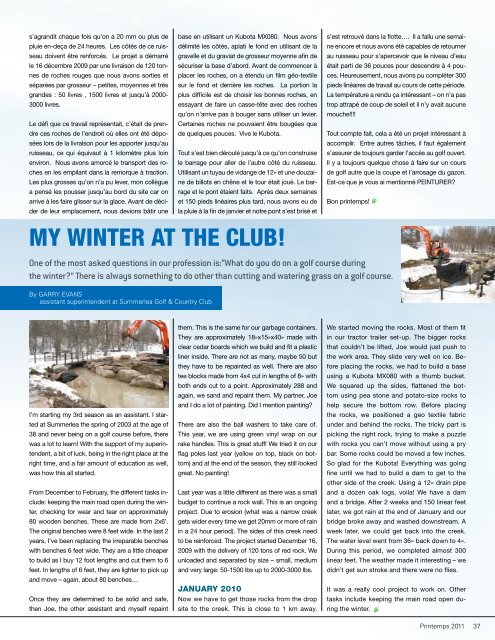


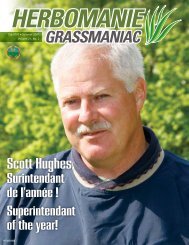
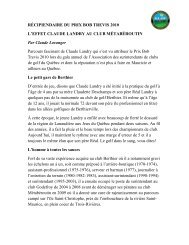

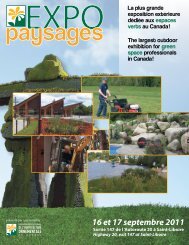



![Prix Bob Trevis - Daniel Read [Mode de compatibilité]](https://img.yumpu.com/38379520/1/190x135/prix-bob-trevis-daniel-read-mode-de-compatibilitac.jpg?quality=85)
